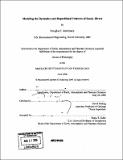| dc.contributor.advisor | David Mohrig. | en_US |
| dc.contributor.author | Jerolmack, Douglas J | en_US |
| dc.contributor.other | Massachusetts Institute of Technology. Dept. of Earth, Atmospheric, and Planetary Sciences. | en_US |
| dc.date.accessioned | 2008-03-26T20:38:00Z | |
| dc.date.available | 2008-03-26T20:38:00Z | |
| dc.date.copyright | 2006 | en_US |
| dc.date.issued | 2006 | en_US |
| dc.identifier.uri | http://dspace.mit.edu/handle/1721.1/37277 | en_US |
| dc.identifier.uri | http://hdl.handle.net/1721.1/37277 | |
| dc.description | Thesis (Ph. D.)--Massachusetts Institute of Technology, Dept. of Earth, Atmospheric, and Planetary Sciences, 2006. | en_US |
| dc.description | Includes bibliographical references. | en_US |
| dc.description.abstract | This thesis seeks to advance our understanding of the dynamic nature, spatial organization and depositional record of topography in sand-bedded rivers. I examine patterns and processes over a wide range of scales, on Earth and Mars. At the smallest scale, ripples and dunes (bedforms) arise spontaneously under most natural flow conditions, acting as the primary agents of sediment transport and flow resistance in sandy rivers. I use physical modeling in a laboratory flume to explore the feedbacks among bedform geometry, fluid flow and sediment transport. Field observations of dunes in the North Loup River, Nebraska, show that bed roughness displays a statistical steady state and robust scaling. Motivated by these data, I develop a nonlinear stochastic surface evolution model for the topography of sandy rivers which captures the essence of bedform evolution in space and time. I then use a simplified kinematic model for bedform evolution to simulate the production of stratigraphy from migrating dunes, allowing a more accurate reconstruction of river flow conditions from preserved bedform remnants in rocks. At the channel scale I examine the conditions that lead to avulsion, the rapid abandonment of a river channel in favor of a new course at lower elevation. | en_US |
| dc.description.abstract | (cont.) Simple scaling arguments and data from 30 natural systems reveal that anastomosing (multi-branch) rivers and distributary deltas are morphologies that arise when avulsion is the dominant mechanism of channel adjustment. I apply these arguments to the Niobrara River, Nebraska, which has experienced rapid in-channel deposition due to base level rise. I show that the planform pattern of the Niobrara is dominated by base-level-driven avulsions, and is decoupled from the smaller-scale sediment transport. At the largest considered scale are depositional fans, which are constructed by avulsing rivers. The evolution of a fan profile may be modeled at long time- and space-averaged scales as a diffusive process. I use such a model to invert topographic and volumetric data from a fluvial fan on Mars, producing an estimate of the time required to build the fan out of channel and overbank deposits. | en_US |
| dc.description.statementofresponsibility | by Douglas J. Jerolmack. | en_US |
| dc.format.extent | 215 leaves | en_US |
| dc.language.iso | eng | en_US |
| dc.publisher | Massachusetts Institute of Technology | en_US |
| dc.rights | M.I.T. theses are protected by
copyright. They may be viewed from this source for any purpose, but
reproduction or distribution in any format is prohibited without written
permission. See provided URL for inquiries about permission. | en_US |
| dc.rights.uri | http://dspace.mit.edu/handle/1721.1/37277 | en_US |
| dc.rights.uri | http://dspace.mit.edu/handle/1721.1/7582 | en_US |
| dc.subject | Earth, Atmospheric, and Planetary Sciences. | en_US |
| dc.title | Modeling the dynamics and depositional patterns of sandy rivers | en_US |
| dc.type | Thesis | en_US |
| dc.description.degree | Ph.D. | en_US |
| dc.contributor.department | Massachusetts Institute of Technology. Department of Earth, Atmospheric, and Planetary Sciences | |
| dc.identifier.oclc | 86123012 | en_US |
